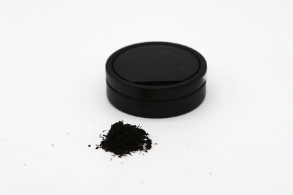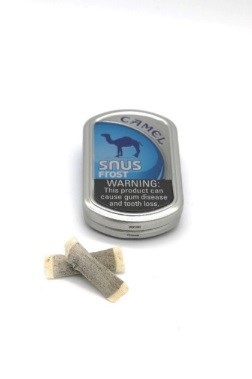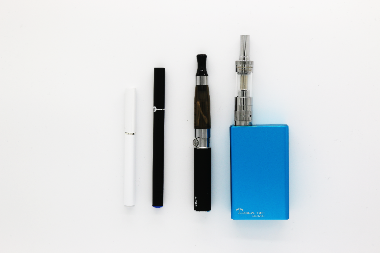Cigarettes
Cigarettes consist of finely chopped tobacco leaves rolled in a paper wrapper.

Is it safe?
- Smoking exposes users to nicotine, carcinogens such as tobacco specific nitrosamines (TSNAs), and other toxic chemicals.
- Cigarettes use negatively affects every organ in the body and is associated with increased risks of:
- Oral diseases/conditions: Oral and pharyngeal cancers, oral mucosal lesions (e.g., oral leukoplakia, nicotine stomatitis), periodontal disease, impaired healing after periodontal treatment, gingival recession, and tooth staining.
- Systemic diseases/conditions: Cardiovascular disease, stroke, COPD, increased risk of cancers, birth‐related complications, craniofacial defects in infants and more.
Cigars (including cigarillos and little cigars)
Cigars are tightly rolled tobacco bundles, wrapped in a tobacco leaf or manufactured tobacco wrapper.
Is it safe?
- Cigar smoke contains the same toxic and carcinogenic compounds as cigarettes including, TSNAs, nitrogen oxides, ammonia, nicotine, carbon monoxide and tar.
- Cigar smoking is associated with:
- Oral diseases/conditions: Oral cancer, lip cancer and periodontal disease.
- Systemic diseases/conditions: laryngeal, esophageal, pancreatic and lung cancer; coronary heart disease, aortic aneurysms and COPD.
Smokeless Tobacco
Dip (oral moist snuff) is finely ground tobacco, packaged loose or in a tea bag-like sachets
Chewing tobacco is coarsely shredded tobacco that is chewed or placed against the cheek.
 Is it safe?
Is it safe?
- Smokeless tobacco (ST), including dip and chew, contains over 28 cancer-causing chemicals.6
- Dipping 8 to 10 times per day exposes the body to as much nicotine as smoking 30 to 40 cigarettes.7
- Use of dip or chew is associated with increased risks of:
- Oral diseases/conditions: gingival keratosis, tooth discoloration, halitosis, erosion, gingival recession, alveolar bone damage, dental caries, tooth loss, oral lesions and oral and pharyngeal cancers.
- Systemic diseases/conditions: pancreatic cancer, nicotine dependence, increased risk of initiating smoking among adolescents
New and emerging tobacco products on the market
Snus
Snus is a new smokeless tobacco product in the US, modeled after Swedish snus. It is finely ground tobacco contained in sachets and used like dip. It is marketed under major cigarette brands.
 Is it safe?
Is it safe?
- Data regarding the health effects of snus is currently inconclusive.
- Snus products may contain lower TSNA levels than conventional ST products, but TSNA levels vary across brands.
- Snus products also contain high nicotine levels, increasing addiction risk.
Electronic Cigarettes (E-cigarettes)
E‐cigarettes, also termed e‐cigs or vape pens, are electronic nicotine delivery systems that heat and convert a liquid mixture (e‐liquid) into an aerosol (commonly termed vapor). E‐cigarettes vary in design, including disposable or rechargeable form
E-cigarettes can be used as a delivery system for nicotine, marijuana, and other illicit drugs.
Is it safe?
- Research shows that e-cigarette use may lead to future smoking or use of other more harmful products.8
- E-cigarettes are currently federally unregulated in the US.
- The long-term oral and systematic health effects of e-cigarettes are currently unknown.
- E-cigarette users are not exhaling water vapor. The aerosol created by e-cigarettes can contain harmful and potentially harmful compounds, such as nicotine, ultrafine particles, diacetyl (chemical linked to lung disease), acetaldehyde, acrolein, toluene formaldehyde, and heavy metals, such as nickel, tin, and lead5,9, although at significantly lower levels than cigarettes.
- To date, few studies have reported the oral health effects of e‐cigarettes. However, due to the nicotine level in most e‐cigarette products, it is possible that e‐cigarettes may adversely affect oral tissues and immune response.
- There is insufficient evidence to support the use of e‐cigarettes as a tobacco cessation aid.
Waterpipe (Hookah)10
- Tobacco waterpipes often consist of a head, body, water bowl, and one or more hoses with individual mouthpieces. Tobacco is placed in the head and heated using charcoal.
- Hookah began in ancient Persia and India and is also known as shisha, goza, hubble-bubble.
- Hookah is usually used with a group of people who share a mouthpiece.
- It comes in many different flavors.

Is it safe?
- Hookah is at least as toxic as cigarettes, delivering nicotine and many of the same health risks.
- Hookah smoke contains high toxic compound levels, including heavy metals, TSNAs, and carbon monoxide, as well as nicotine.
- Research suggests that one hookah smoking session can expose users to smoke at levels equivalent to 100 cigarettes due to the length of time and second hand smoke exposure during the smoking session
References
Modified from:
- US DHHS. "The health consequences of smoking—50 years of progress: A report of the surgeon general." Atlanta, GA: US Department of Health and Human Services, Centers for Disease Control and Prevention, National Center for Chronic Disease Prevention and Health Promotion, Office on Smoking and Health 17 (2014)
- Winn, Deborah M. "Tobacco use and oral disease." Journal of Dental Education 65.4 (2001): 306‐312.
- The National Cancer Institute. Smokeless Tobacco and Cancer. Available at: https://www.cancer.gov/about- cancer/causes-prevention/risk/tobacco/smokeless-fact-sheet. [Accessed 2017 Aug 4].
- International Agency on Research for Cancer. Smokeless tobacco and some tobacco-specific N-nitrosamines. Monographs, vol. 89. Lyon: IARC; 2007. ISBN: 978 92 832 1289 8.
- NIDA. Teens using e-cigarettes may be more likely to start smoking tobacco. National Institute on Drug Abuse website. Available at: https://www.drugabuse.gov/news-events/news-releases/2015/08/teens-using-e-cigarettes- may-be-more-likely-to-start-smoking-tobacco. August 18, 2015. [Accessed 2017 Sept 1].